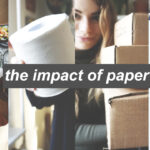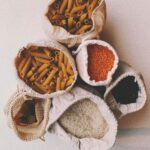Production: Paper is a dried, compressed mat of plant fibers. Most paper is made from forest trees though it can also be made from bamboo, cotton, hemp, jute, and a wide range of other plant materials. Smooth papers used for magazines or packaging often have materials such as china clay added so they print with a more colorful, glossy finish. There are also mixed paper materials that mix paper and plastic, like Tetra-Pak which is what milk and juice cartons are often made of.
Cardboard is slightly different from paper, although the materials are the same. Cardboard is thicker and made with more layers of fiber than paper, cardboard also consists of more reused fibers rather than virgin fibers, giving it its characteristic brown/grey color.
ALSO WATCH: the impact of aluminum

ALSO WATCH: the impact of glass
The process with which we produce paper is pretty simple, you can actually make it at home: you take a plant, bash it release the fibers, then you mix it with water to get a soggy mixture of fibers called pulp, Then you spread the pulp out on a wire mesh so the fibers knit and bond together, squeeze the water away, dry out your pulp, and what you’ve got is paper! Depending on the purpose of the product there are other steps on the process as well as chemical dyes or bleach.

So paper is made from plants, that a good thing, right? Well a lot of plants, specifically trees go into the process of paper production and that comes with downsides, one of them is deforestation. Worldwide, deforestation is estimated to be responsible for about 12% of greenhouse gas emissions. Trees absorb CO2 and turn it into oxygen, so when loggers and developers cut tress down they create massive areas where this process is no longer possible. As a result, massive areas will not be able to take CO2 out of the atmosphere. Deforestations also comes with other downsides like loss of biodiversity and monocultures.
It can take up to 24 trees to make 1 ton of office paper. The Union of Concerned Scientists points out that “wood products,” including paper, account for about 10% of total deforestation. Animal agriculture, soy production (mostly for livestock) and palm oil production are to blame for the majority of the world’s deforestation. So deforestation is a downside of paper production, but the impact of paper can be seen in the manufacturing process as well – paper making is very water and energy-intensive. Along with the use of bleaching agents, this can produce water and air pollution.
There is also the notion of landfills – The demand for using cardboard as a packaging material has made it the single largest waste product (by weight) in your trash and it is estimated that over 24 million tons of cardboard is discarded each year. Unrecycled paper and cardboard contributes to groundwater pollution and it emits methane when breaking down in landfills
The United States produced about over 20 million tons of this paper last year, which takes 55 to 110 million trees to produce.
Usage: We use lots of paper and cardboard every day. It’s one of those types of packaging that I, as well as many other zero wasters, prefer when we look for alternatives to plastic. Right now there are over 400 million tons of paper and cardboard being manufactured worldwide. A lot of paper and cardboard is recycled, we’ll talk more about that in a minute, but we also produce paper products that are not designed to be recycled. Stuff like toilet paper and receipts are daily commodities in most households.
Receipts waste 1 billion gallons of water, to make them, we kill 10 million trees, to supply them, we use 250 million gallons of oil, and overall, receipts make for 1.5 billion pounds of waste. On average, 384 trees are used to supply 1 person with a lifestyle supply of toilet paper. It takes up to 20 years for a tree to grow big enough for paper production and we flush thousands of them down the drain. Fun fact before 1935 toilet paper came with splinters in it.
Also watch: ZERO WASTE TOILET PAPER

Recycling: Luckily about 58% of the global paper usage is being recycled, in Europe its 73%, and the recycling rate in the US is around 64%. So how much effect on the environment does recycling one ton of cardboard have? It saves us around 9 cubic yards of landfill space, 700 gallons of water, and 46 gallons of oil. Recycling is vital because about a third of new paper comes from recycled paper. Another third is from waste such as sawdust and scrap from lumber mills, according to the EPA
Actually, recycled paper has overtaken wood pulp as the main source of raw materials. Every ton of paper recycled saves more than 3.3 cubic yards of landfill space, and if you measure by weight, more paper is recovered for recycling than plastic, aluminum, and glass combined.
Also watch: WHAT I BUY IN PAPER PACKAGING

When we look at how paper and cardboard are recycled there are a couple of things that are neat to know. Paper comes in different grades. The grade determines the quality and how easy it is to recycle.
A newspaper is a lower grade paper because it has already been recycled numerous times, while printer paper is higher grade paper. The grade of paper is determined by fiber length, which shortens after each trip through the recycling process. After being recycled five to seven times, the fibers become too short to make new paper and will need to be mixed with virgin fibers. So paper does not have to end up as a waste product, but it has to be mixed with more and more new fibers to continue in the production circle.
Also watch: WHAT HAPPENS TO ONLINE RETURNS

How to recycle properly:
- Sort the paper and cardboard into clean materials and other mixes, like tetrapak and sticky notes. Some recycling facilities do actually accept these, but not all, so check before you through this stuff in the recycling bin.
- Remove paper clips and staples. Actually many recycling facilities have machines that remove these for you, but often you can reuse stuff like paper clips, so that’s always better than tossing them.
- Paper and cardboard that has been in touch with food, like pizza boxes are unrecyclable, and throwing it will actually ruin the entire batch. Instead, cut out the greasy parts and only recycle the clean parts.
- Wet paper is often unrecyclable, so before you recycle your paper, make sure that it is dry.
- Lots of cardboard food packaging from the frozen section seems like 100% cardboard but many of them have a small and think layer of plastic on the inside to protect it from moisture. It is the same with paper cups as well. These products are not able to be turned into new paper materials because they are mixed with plastic. Sometimes you can remove the plastic, but other times it is impossible.
The showdown: So what is more sustainable paper or plastic? It all comes down to the product and how you use it. To-go coffee cups for instance. Styrofoam has the lowest carbon footprint compared to paper and ceramics, but that only takes the CO2 into account. Such statistics often fail to take methane emissions, disposal, and reusability into account. A reusable cup is more sustainable than both paper and plastic. Paper production often comes with a larger carbon footprint than plastic, because the plastic weighs less, so less material has to be used in order to make the product. As a result, a paper bag often has a larger carbon footprint than a plastic bag. But again here we are not taking microplastic, methane, water pollution, and ocean plastic into account. Paper and cardboard as disposables often have a large carbon footprint, and often disposables used for food and drinks cannot be recycled either. Where it wins over plastic is when it can be composted and function in a circular loop. But most consumers just toss their paper utensils and plates, makes them just a bad, and sometimes even worse than plastic.




